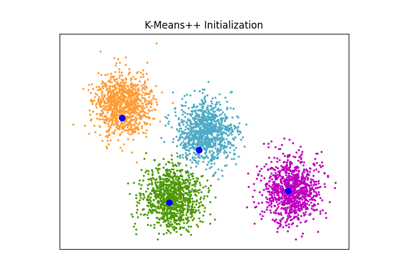sklearn.cluster.kmeans_plusplus#
- sklearn.cluster.kmeans_plusplus(X, n_clusters, *, sample_weight=None, x_squared_norms=None, random_state=None, n_local_trials=None)[source]#
Init n_clusters seeds according to k-means++.
New in version 0.24.
- Parameters:
- X{array-like, sparse matrix} of shape (n_samples, n_features)
The data to pick seeds from.
- n_clustersint
The number of centroids to initialize.
- sample_weightarray-like of shape (n_samples,), default=None
The weights for each observation in
X. IfNone, all observations are assigned equal weight.sample_weightis ignored ifinitis a callable or a user provided array.New in version 1.3.
- x_squared_normsarray-like of shape (n_samples,), default=None
Squared Euclidean norm of each data point.
- random_stateint or RandomState instance, default=None
Determines random number generation for centroid initialization. Pass an int for reproducible output across multiple function calls. See Glossary.
- n_local_trialsint, default=None
The number of seeding trials for each center (except the first), of which the one reducing inertia the most is greedily chosen. Set to None to make the number of trials depend logarithmically on the number of seeds (2+log(k)) which is the recommended setting. Setting to 1 disables the greedy cluster selection and recovers the vanilla k-means++ algorithm which was empirically shown to work less well than its greedy variant.
- Returns:
- centersndarray of shape (n_clusters, n_features)
The initial centers for k-means.
- indicesndarray of shape (n_clusters,)
The index location of the chosen centers in the data array X. For a given index and center, X[index] = center.
Notes
Selects initial cluster centers for k-mean clustering in a smart way to speed up convergence. see: Arthur, D. and Vassilvitskii, S. “k-means++: the advantages of careful seeding”. ACM-SIAM symposium on Discrete algorithms. 2007
Examples
>>> from sklearn.cluster import kmeans_plusplus >>> import numpy as np >>> X = np.array([[1, 2], [1, 4], [1, 0], ... [10, 2], [10, 4], [10, 0]]) >>> centers, indices = kmeans_plusplus(X, n_clusters=2, random_state=0) >>> centers array([[10, 2], [ 1, 0]]) >>> indices array([3, 2])

